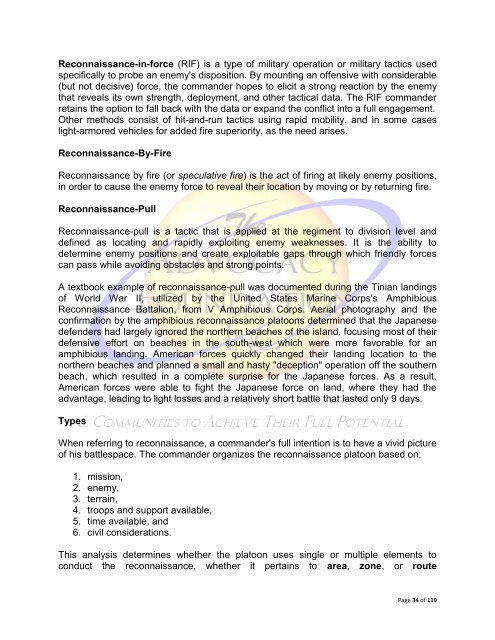International Legal Evangelism: Intelligence, Reconnaissance & Missions
International Legal Evangelism: Intelligence, Reconnaissance & Missions
International Legal Evangelism: Intelligence, Reconnaissance & Missions
You also want an ePaper? Increase the reach of your titles
YUMPU automatically turns print PDFs into web optimized ePapers that Google loves.
<strong>Reconnaissance</strong>-in-force (RIF) is a type of military operation or military tactics used<br />
specifically to probe an enemy's disposition. By mounting an offensive with considerable<br />
(but not decisive) force, the commander hopes to elicit a strong reaction by the enemy<br />
that reveals its own strength, deployment, and other tactical data. The RIF commander<br />
retains the option to fall back with the data or expand the conflict into a full engagement.<br />
Other methods consist of hit-and-run tactics using rapid mobility, and in some cases<br />
light-armored vehicles for added fire superiority, as the need arises.<br />
<strong>Reconnaissance</strong>-By-Fire<br />
<strong>Reconnaissance</strong> by fire (or speculative fire) is the act of firing at likely enemy positions,<br />
in order to cause the enemy force to reveal their location by moving or by returning fire.<br />
<strong>Reconnaissance</strong>-Pull<br />
<strong>Reconnaissance</strong>-pull is a tactic that is applied at the regiment to division level and<br />
defined as locating and rapidly exploiting enemy weaknesses. It is the ability to<br />
determine enemy positions and create exploitable gaps through which friendly forces<br />
can pass while avoiding obstacles and strong points.<br />
A textbook example of reconnaissance-pull was documented during the Tinian landings<br />
of World War II, utilized by the United States Marine Corps's Amphibious<br />
<strong>Reconnaissance</strong> Battalion, from V Amphibious Corps. Aerial photography and the<br />
confirmation by the amphibious reconnaissance platoons determined that the Japanese<br />
defenders had largely ignored the northern beaches of the island, focusing most of their<br />
defensive effort on beaches in the south-west which were more favorable for an<br />
amphibious landing. American forces quickly changed their landing location to the<br />
northern beaches and planned a small and hasty "deception" operation off the southern<br />
beach, which resulted in a complete surprise for the Japanese forces. As a result,<br />
American forces were able to fight the Japanese force on land, where they had the<br />
advantage, leading to light losses and a relatively short battle that lasted only 9 days.<br />
Types<br />
When referring to reconnaissance, a commander's full intention is to have a vivid picture<br />
of his battlespace. The commander organizes the reconnaissance platoon based on:<br />
1. mission,<br />
2. enemy,<br />
3. terrain,<br />
4. troops and support available,<br />
5. time available, and<br />
6. civil considerations.<br />
This analysis determines whether the platoon uses single or multiple elements to<br />
conduct the reconnaissance, whether it pertains to area, zone, or route<br />
Page 34 of 119

















